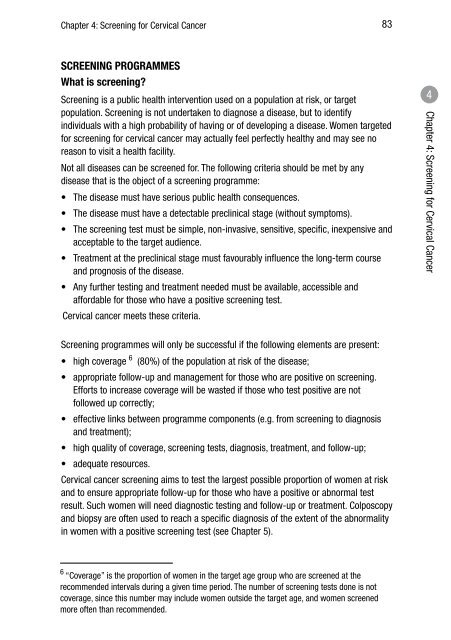CHAPTER 4: SCREENING FOR CERVICAL CANCER
CHAPTER 4: SCREENING FOR CERVICAL CANCER
CHAPTER 4: SCREENING FOR CERVICAL CANCER
You also want an ePaper? Increase the reach of your titles
YUMPU automatically turns print PDFs into web optimized ePapers that Google loves.
Chapter 4: Screening for Cervical Cancer 83<strong>SCREENING</strong> PROGRAMMESWhat is screening?Screening is a public health intervention used on a population at risk, or targetpopulation. Screening is not undertaken to diagnose a disease, but to identifyindividuals with a high probability of having or of developing a disease. Women targetedfor screening for cervical cancer may actually feel perfectly healthy and may see noreason to visit a health facility.Not all diseases can be screened for. The following criteria should be met by anydisease that is the object of a screening programme:• The disease must have serious public health consequences.• The disease must have a detectable preclinical stage (without symptoms).• The screening test must be simple, non-invasive, sensitive, specific, inexpensive andacceptable to the target audience.• Treatment at the preclinical stage must favourably influence the long-term courseand prognosis of the disease.• Any further testing and treatment needed must be available, accessible andaffordable for those who have a positive screening test.Cervical cancer meets these criteria.4Chapter 4: Screening for Cervical CancerScreening programmes will only be successful if the following elements are present:• high coverage 6 (80%) of the population at risk of the disease;• appropriate follow-up and management for those who are positive on screening.Efforts to increase coverage will be wasted if those who test positive are notfollowed up correctly;• effective links between programme components (e.g. from screening to diagnosisand treatment);• high quality of coverage, screening tests, diagnosis, treatment, and follow-up;• adequate resources.Cervical cancer screening aims to test the largest possible proportion of women at riskand to ensure appropriate follow-up for those who have a positive or abnormal testresult. Such women will need diagnostic testing and follow-up or treatment. Colposcopyand biopsy are often used to reach a specific diagnosis of the extent of the abnormalityin women with a positive screening test (see Chapter 5).6 “Coverage” is the proportion of women in the target age group who are screened at therecommended intervals during a given time period. The number of screening tests done is notcoverage, since this number may include women outside the target age, and women screenedmore often than recommended.
















